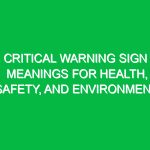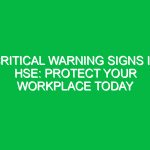Welcome to Today’s Toolbox Talk
Hello team! Thank you for gathering today for our Toolbox Talk. The focus of our discussion will be on Hazard Elimination within our daily operations. As we strive to create a safe working Environment, understanding and implementing effective hazard elimination techniques is crucial for everyone on the team. Today, we will explore practical tips, real-life examples, and Best Practices to enhance our Safety culture.
Understanding Hazard Elimination
Before we dive deeper, let’s clarify what we mean by Hazard Elimination. In the context of Health, Safety, and Environment (HSE), it refers to the process of identifying and removing potential Hazards before they can cause harm to employees, equipment, or the environment. This proactive approach is essential for maintaining Safety and compliance with Regulations.
The goal of hazard elimination is to create a workspace where risks are minimized, and everyone can perform their tasks safely. Remember, safety is not just a priority; it’s a value we all share.
Why Focus on Hazard Elimination?
Focusing on Hazard Elimination has numerous Benefits, including:
- Reducing Accidents: By identifying and eliminating Hazards, we can significantly decrease the likelihood of workplace accidents.
- Enhancing Productivity: A safe working environment leads to higher morale and productivity among employees.
- Compliance with Regulations: Following hazard elimination practices helps us comply with local, state, and federal regulations.
- Cost Savings: Preventing accidents means fewer medical claims, legal fees, and potential fines.
Key Components of Hazard Elimination
To effectively eliminate hazards, we need to understand the key components involved. Here are the main aspects:
- Hazard Identification: The first step is to identify potential hazards in the workplace. Regular inspections and employee feedback are essential in this process.
- Risk Assessment: Once hazards are identified, assess the risk associated with each hazard. Determine the severity and likelihood of potential incidents.
- Control Measures: Implement Control Measures to eliminate or reduce the identified risks. This may include engineering controls, administrative controls, or Personal Protective Equipment (PPE).
- Monitoring and Review: Continuously monitor the effectiveness of the Control Measures. Regular reviews help ensure that new hazards are identified and addressed promptly.
Real-Life Examples of Hazard Elimination
To illustrate the importance of hazard elimination, let’s discuss a few real-life scenarios:
Scenario 1: Construction Site
Imagine a construction site where workers frequently use heavy machinery. A hazard assessment reveals that loose debris on the ground poses a tripping hazard. By implementing a daily cleanup protocol, the site manager effectively eliminates this hazard, preventing potential injuries.
Scenario 2: Chemical Handling
In a laboratory setting, employees work with hazardous chemicals. A risk assessment indicates that spills can lead to severe injuries. By introducing secondary containment systems and Training employees on spill response Procedures, the laboratory successfully eliminates the risk associated with chemical spills.
Best Practices for Effective Hazard Elimination
Here are some Best Practices to keep in mind when focusing on Hazard Elimination:
- Encourage Open Communication: Foster an environment where employees feel comfortable reporting hazards without fear of repercussions.
- Conduct Regular Training: Provide ongoing training to ensure everyone understands hazard identification and elimination procedures.
- Incorporate Technology: Utilize technology, such as safety apps or software, to streamline hazard reporting and tracking.
- Engage Employees: Involve employees in the hazard elimination process. Their firsthand experiences provide valuable insights into potential risks.
Steps to Implement Hazard Elimination
Implementing hazard elimination involves a series of steps:
- Conduct a Hazard Assessment: Regularly assess your workspace for potential hazards. Document your findings carefully.
- Prioritize Hazards: Rank hazards based on their severity and likelihood. Focus on eliminating the most critical hazards first.
- Develop an Action Plan: Create a plan outlining the steps needed to eliminate or control each identified hazard.
- Communicate the Plan: Share the action plan with all team members. Ensure everyone understands their roles in the process.
- Review and Revise: Regularly review the effectiveness of your hazard elimination strategies and make necessary adjustments.
Regulations and Standards: Compliance is Key
Compliance with regulations and standards is crucial for effective hazard elimination. Familiarize yourself with relevant regulations such as:
- Occupational Safety and Health Administration (OSHA) standards
- Environmental Protection Agency (EPA) regulations
- Company-specific safety policies
Understanding these regulations ensures that our workplace adheres to safety standards, ultimately protecting employees and minimizing legal risks.
Open Discussion: Your Input Matters
Now that we’ve covered the essential aspects of Hazard Elimination, let’s open the floor for discussion. Here are a few questions to consider:
- What hazards have you identified in your work area?
- How can we improve our current hazard elimination practices?
- What additional training or resources do you think would help us in this area?
Your feedback is invaluable as we work together to create a safer environment.
Conclusion: Our Shared Commitment to Safety
As we conclude today’s Toolbox Talk, let’s remember the importance of Hazard Elimination in our daily operations. By actively engaging in identifying and eliminating hazards, we contribute to a safer workplace for everyone.
Thank you all for your attention and commitment to safety. Remember, safety is a shared responsibility, and every small action counts toward making our workplace better. Let’s stay vigilant and proactive in our approach to hazard elimination!


